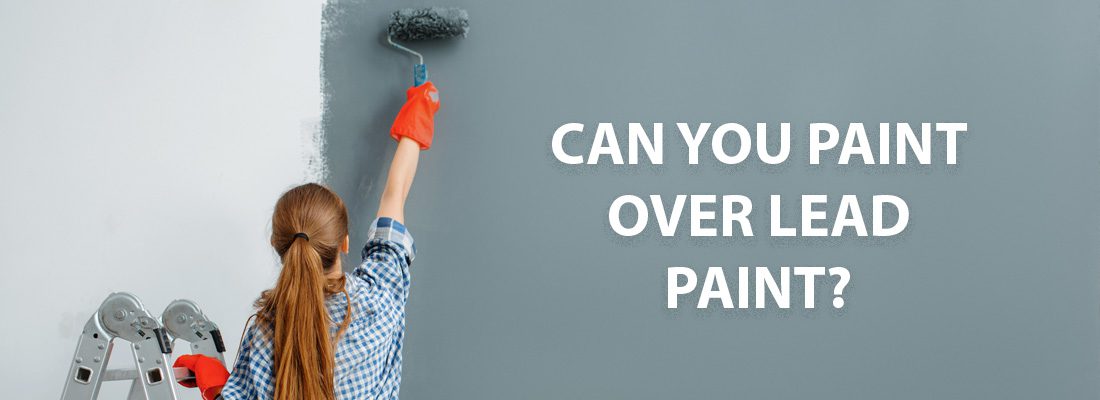Can you paint over lead paint? The answer is yes. Whether you’re flipping an older home for a profit or planning to live there, finding the presence of lead in your paint might feel like a major setback.
Luckily, as long as you use the correct type of paint, you can paint over lead paint. This is known as encapsulation. Using a type of paint called an encapsulant, the lead paint is sealed off so that it cannot contaminate your home.
How to Paint over Lead Paint
Can you paint over lead paint? Yes. But how? The answer is that it takes a little more work than a traditional paint job. Make sure you follow these steps when painting over lead-based paint.
- Test the paint. If your home was built before 1978, you’ll want to test the paint to determine whether or not lead is present. You can opt for a DIY testing kit, but an analysis from a professional lead testing lab will be more accurate.
- If you have lead paint in your home, you’ll want to look at the condition of the paint. As long as the finish of the lead paint is intact, you can use encapsulation to paint over lead-based paint. However, if the lead-based paint is cracked or otherwise in poor condition, you cannot safely encapsulate it. If this is the case, you’ll need to hire a professional to remove the lead-based paint from your home.
- Remove all household items and furniture from the room you’re working on.
- Seal off the area you’re working on with plastic sheeting to prevent lead-contaminated dust from traveling to other areas of the home.
- Wipe down the surface with a wet cloth. Never chip, scrape, or sand lead-based paint.
- Follow the manufacturer’s instructions on your encapsulant to apply the paint. Most of the time, this will mean using a brush, roller, or airless paint sprayer to apply the encapsulant.
Why Lead Paint is Dangerous
Lead is poisonous for humans, particularly children who are still developing. When lead paint is disturbed, it becomes airborne. You might breathe in the lead-laced particles, or it might settle on your furniture. When inhaled or consumed, lead-based paint causes lead poisoning.
Mild symptoms of lead poisoning include nausea, headaches, trouble sleeping, and loss of appetite. Longer-term exposure to lead can lead to severe lead poisoning, which causes memory loss, vomiting, weakness, aggressive behavior, seizures, comas, and confusion.
Precautions to Take
Because of the dangers of lead poisoning, lead-based paint needs to be handled properly. Even if the lead paint is still in good condition, you need to take precautions to stay safe.
- Wear protective gear, including a respirator, goggles, gloves, shoe covers, and coveralls.
- Never scrape or sand lead paint. This will release lead particles into the air.
- Keep children and adults with at-risk health conditions away from the home until the project is complete.
- Use a HEPA filter while you work, as well as for a little bit after, to filter out the lead dust that might have been kicked into the air.
- Make sure you wash all of your protective gear at the end of each day. Throw away disposable protective gear. Wash your clothing thoroughly. You don’t want to contaminate other parts of the house with lead dust!
- Wash your painting tools thoroughly after the project is done. Dispose of all drop cloths and plastic sheets used during the project
Types of Paint to Use
When painting over lead paint, you can’t use typical oil or water-based paint. The toxins from the lead will still seep through typical paints. Instead, you’ll need to purchase a special kind of paint called an encapsulant. Encapsulants are thicker than typical paint and keep the lead protected behind a membrane. Encapsulants are available at just about any paint or hardware store.
There are three types of encapsulants:
- Traditional polymers
- Epoxy or polyurethane polymers
- Cement-like products that contain polymers
If you’re taking on the project yourself, you’ll probably want to stick with a polymer and epoxy-based encapsulant. Cement-like products require mixing that can be tricky for DIYers.
Benefits of Hiring a Painting Company vs DIY
After asking “Can you paint over lead paint?” and finding out that you can, you might be tempted to DIY the project. If you only have one room to worry about or a piece of furniture, painting over the lead-based paint on your own might be just fine. However, hiring a professional painting company to paint over your lead paint comes with many benefits:
- Painting companies, like the pros at Boise Home Painting, are trained specifically on how to handle painting over lead-based paint.
- A professional painting company can evaluate the condition of your paint to see if it’s eligible for encapsulation.
- Professionals have to follow the EPA regulations in the Renovation, Repair, and Painting rule, which means you can be sure the job is done correctly.
- Perhaps one of the biggest benefits of hiring a painting company overdoing it yourself is peace of mind. Lead paint poses a serious safety risk for all occupants of the home. You want to know that you’re safe in your home.
If you need to encapsulate lead-based paint in your home, you can count on the professionals at Boise Home Painting. We’ll protect your family from the dangers of lead paint and give you peace of mind that’s worth its weight in gold. We serve the entire Boise area with commercial and residential painting including Merdian, Caldwell, and Eagle. Click here to get your free estimate!

